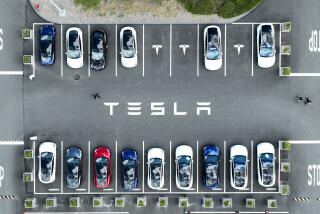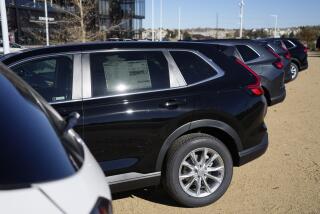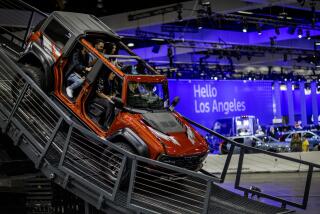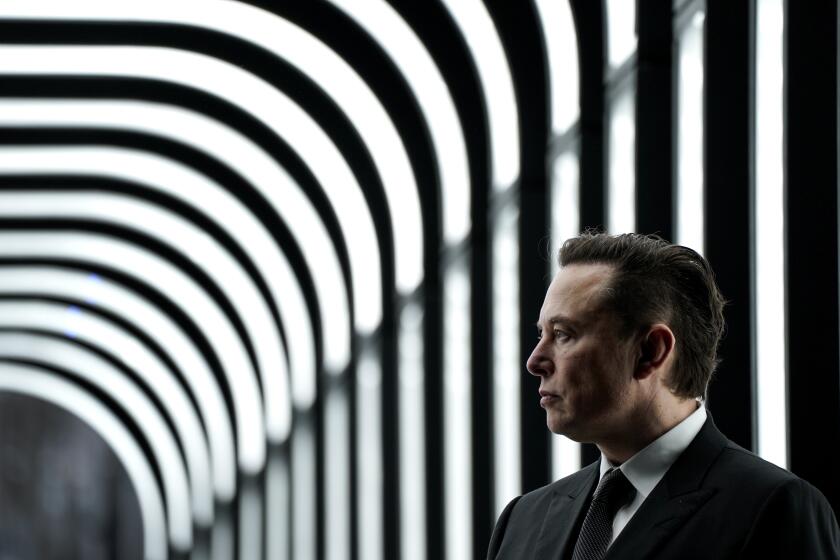L.A. Auto Show comes roaring back
- Share via
What a difference a year makes.
Only 12 months ago, the auto industry was staggering under the weight of bankruptcies, factory and dealer closures, mega-layoffs and the deepest sales slump in decades.
The malaise spilled into the Greater Los Angeles Auto Show.
Nissan Motor Co., a manufacturer that once called Southern California its U.S. home, skipped the event. Chrysler Group was there in name only, hosting a static display of aging vehicles. The buzz on the floor was whether General Motors Co. and Chrysler Group would survive and how big a dent a slew of recalls would put in Toyota Motor Co. sales.
But this year Nissan is back, touting its new Leaf electric vehicle, a new minivan, a convertible version of its Murano crossover and a futuristic concept sedan. Chrysler will be showing off as many as eight new and updated vehicles, including its all-new Dodge Charger sedan and Durango SUV. And Fiat will attend the show for the first time since it exited the U.S. market 27 years ago. It will show off its tiny, fuel-sipping Fiat 500, which goes on sale next year and is modified from the European version for the North American market.
The major auto companies are renting 10% more space to fill the two largest exhibit halls at the Los Angeles Convention Center, and smaller exhibitors have booked the remaining conference halls. Organizers are hoping an attendance rebound will push the number of visitors close to the 900,000 mark, compared with 760,000 last year.
Even Hollywood plans to attend.
Columbia Pictures will show off the Black Beauty — the 1965 Chrysler Imperial that is the automotive star of its upcoming movie “The Green Hornet.” The studio modified 29 of the vintage sedans for the film, adding simulated hood guns, bumper rockets and a grill-mounted flamethrower. It destroyed all of the cars during shooting of the film, which will open in January, but rebuilt three for the show circuit.
Elsewhere at the Los Angeles Convention Center, Hyundai Motor Co. will display its new Elantra, made domestically at its Montgomery, Ala. factory. Hyundai’s sister company Kia Motors Corp. will unveil its first hybrid, a version of the Optima sedan. Porsche will showcase its new 911 Carrera GTS as well as its 911 Speedster. Audi will bring its new A7 Sportback, and BMW will display its redesigned X3 crossover.
As the industry rebounds, executives and analysts are taking note of the growing importance of the Los Angeles show as a stage for green cars.
“L.A. is now No. 2 after the Detroit show now in terms of importance,” said Jake Fisher, a senior automotive engineer with Consumer Reports. “It is coming into its own because of all of the green vehicles. Los Angeles is the ideal place to launch these types of cars.”
Honda Motor Co. is coming with an eco-arsenal. It will host a world debut for an all-new electric vehicle concept that’s expected to go into production for the 2012 model year and it will reveal a plug-in hybrid platform showcasing the next generation of Honda hybrid technology. Both will be on display next to the automaker’s hydrogen-powered FCX Clarity vehicle.
“Years before, Honda would have held that news for Detroit,” Fisher said.
Toyota and Tesla Motors Inc. will for the first time show off their jointly developed electric RAV4 SUV. The vehicle goes on sale in 2012.
Automakers see L.A. as a “critical” show because the region is an “environment that set a huge number of driving trends,” said Jim Federico, GM’s engineering chief. “As I drive around Southern California, I have never seen so many Priuses in one place.”
Switching the date of the show — which will be open to the public Friday through 28 — has helped bolster its importance, said Fisher.
Up through 2005, the Los Angeles show was held in January and overlapped with the Detroit show.
“It was difficult for manufacturers to have cars in two places at the same time. And as a result Detroit ended up with most of the significant debuts,” said Brendan Flynn, the Los Angeles show’s spokesman.
In 2006 organizers moved the event to November, enabling the auto companies to make important announcements in Los Angeles without having to worry about what was going on in Detroit.
This year 50 new models will make their North American debut at the L.A. show, and 20 designs will be unveiled for the first time.
Certainly it helps that the auto market is coming back. U.S. auto sales have risen 10.6% this year to 9.6 million vehicles. The industry is on a pace to sell about 11.5 million vehicles this year. Although that’s still low by historical standards — and miles from the 16 million to 17 million that was counted for much of the last decade — it’s a step up from last year.
The wrenching transition of the industry over the last 18 months has allowed automakers to profit at much smaller sales volumes. Gone are the showroom-clearing and money-losing incentive wars fought by the domestic brands even just a few years ago.
Last month, Ford posted a record $1.7-billion third-quarter profit and said it expected to be solidly profitable for the entire year. Its strong cash flow — a result of selling vehicles for higher transaction prices and offering fewer discounts — is allowing the Dearborn, Mich., company to restore its balance sheet to health.
Ford is better off now than when the industry was selling millions more cars, said analyst Shelly Lombard of the corporate credit research firm Gimme Credit, “because it can make money even with industry volume that’s down 30% from historical levels, it’s less reliant on trucks and SUVs, and its in-demand cars are selling without hefty incentives.”
GM is clawing its way back to health. The Detroit automaker reported its third consecutive profitable quarter Wednesday and is on track to have its first full-year profit since 2004.
Bolstered by better sales and cost-cutting measures, GM earned $2 billion in the third quarter. Revenue rose to $34.1 billion, up 27% from the same quarter last year, which included nine days when the company was in bankruptcy.
From 2005 to 2009, the automaker had about $88 billion in losses.
In the coming weeks, probably during the course of the Los Angeles show, GM will hold a $13-billion public stock offering. It said the price of the shares would be $26 to $29, depending on investor demand for the stock.
The offering will reduce the government’s ownership to minority status, taking it to about 43% of the company from the current 61%. Taxpayers became the main owners of GM during its bankruptcy reorganization and federal bailout last year.
Chrysler, too, has stanched its bleeding. It reported a third-quarter operating profit last week of $239 million, narrowing its net loss to $84 million, its smallest quarterly loss since exiting bankruptcy protection last year.
The Auburn Hills, Mich., automaker saw its revenue climb more than 5% to $11 billion, and it is looking to hold an initial public stock offering next year.
But despite these gains in both the auto market and at the Los Angeles show, some wonder whether the globalization of the industry might reduce Southern California’s importance in the coming years.
Although there will be lots of cars, the Los Angeles show will suffer from a dearth of the top managers of the world’s car companies, said Jeremy Anwyl, chief executive of auto industry information company Edmunds.com.
Honda Chief Executive Takanobu Ito will be there talking about his company’s electric car initiatives. Mark Fields, Ford’s president of the Americas, also will be attending, pitching the new Ford Focus and talking about his company’s increasing reliance on global platforms and engineering.
But the top bosses from GM will be absent, as will the top German brass from Mercedes and BMW. Toyota President Akio Toyoda also is expected to be a no-show.
“The priority of global markets is shifting,” Anwyl said. “China is probably a bigger deal now.”







